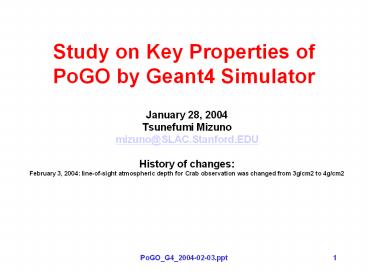Study on Key Properties of PoGO by Geant4 Simulator - PowerPoint PPT Presentation
1 / 12
Title:
Study on Key Properties of PoGO by Geant4 Simulator
Description:
February 3, 2004: line-of-sight atmospheric depth for Crab observation was ... detector responses are convoluted. 100mCrab (20-200keV), 6 hour exposure, 217 units ... – PowerPoint PPT presentation
Number of Views:25
Avg rating:3.0/5.0
Title: Study on Key Properties of PoGO by Geant4 Simulator
1
Study on Key Properties of PoGO by Geant4
Simulator
- January 28, 2004
- Tsunefumi Mizuno
- mizuno_at_SLAC.Stanford.EDU
- History of changes
- February 3, 2004 line-of-sight atmospheric depth
for Crab observation was changed from 3g/cm2 to
4g/cm2
2
Simulated Geometry
- Thickness of fast scint. 2.63cm
- (D 2.23cm)
- W (thickness of slow scint.) 0.2cm
- L1 (slow scint. length) 60cm
- L2 (fast scint. length) 20cm
- Thickness of W collimator 0.0025cm
- Thickness of btm BGO 2.68cm
- Length of btm BGO 3cm
- (not tapered in simulator for simplicity)
- Gap between BGOs 0.5cm
- (including BaSo4 eflector)
- Thickness of side Anti BGO 3cm
- Length of side Anti BGO 60cm
- of units 397 (geometrical area of fast scint.
not covered by slow scint. 1709 cm2) or 217
(934.4 cm2)
3
Simulation Condition
- The same Crab spectrum as that used in Hiros
EGS4 simulation is simulated here. That is, - E-2.1 spectrum with 100mCrab intensity, 20-200keV
(300.8 c/s/m2) - 100 polarized, 6h exposure
- Attenuation by air of 4g/cm2 (atmospheric depth
in zenith direction is 3g/cm2 and that in
line-of-sight direction is 4g/cm2) - Atmospheric downward/upward gamma spectra for
GLAST BFEM simulation are used as background. - Use Geant4 ver5.1. Possible minor bug of
polarization vector after scattering was fixed by
user (found by Y. Fukazawa _at_ Hiroshima Univ.).
4
Detector Resopnses
- The same detector responses as those used in
Hiros EGS4 simulation - If there is a hit in slow/anti/btm scintillators,
event is rejected. (Threshold is 3 keV). Energy
smearing and poisson fluctuation are not taken
into account yet for veto scintillators. - Assumed detector resposes
- 0.5 photo-electron/keV
- fluctuated by poisson distribution
- smeared by gaussian of sigma0.5 keV (PMT energy
resolution) - minimum hit threshold after three steps above is
3 keV
5
Event Analysis
- The same as those of Hiros EGS4 Simulation
- Use events in which two or three fast
scintillators are with hit. - The largest energy deposit is considered to be
photo absorption - Second largest energy deposit is considered to be
compton scattering. - Smallest energy deposit (in case of three
scintillators with hit) is ignored. - Smear azimuth angle distribution with Hiros
resolution function. - No event selection on compton kinematics
6
Incident/measured gamma-ray energy distributions
100mCrab (20-200keV), 6 hour exposure, 217 units
Incident gamma energy, 2 or 3 hits in fast scint.
no hits in veto scinti. (Eth3keV)
after attenuated by air of 3g/cm2
measured gamma energy, detector responses are
convoluted
7
Incident energy distribution of atmospheric gammas
Reduced Design (217 units)
atmospheric downward gamma
atmospheric upward gamma
gammas that hit 2 or 3 fast scintillators
gammas that pass the event selection (background)
Downward atmospheric gammas below a few MeV and
upward ones between a few hundred keV to a few
MeV contribute to background.
8
Collimator thickness dependence of the
background(1)
atmospheric downward gamma
397 units
217 units
100mCrab (incident)
100mCrab (detected)
Background due to atmospheric gamma 10um
thickness 25um thickness 50um thickness
- of units does not affect S/N ratio very much
- Collimator (W) of 25um could be optimum (see the
next slide). - Signalgtbackground below 100 MeV.
9
Collimator thickness dependence of the
background(2)
atmospheric upward gamma
217 units
397 units
100mCrab (incident)
100mCrab (detected)
Background due to atmospheric gamma 10um
thickness 25um thickness 50um thickness
- of units does not affect the S/N ratio very
much - Collimator (W) of 25um could be optimum (see the
previous slide). - Signalgtbackground below 100 MeV.
10
Slow scint. energy threshold dependence of the
background
Reduced Design (217 units)
atmospheric downward gamma
atmospheric upward gamma
100mCrab (incident)
100mCrab (detected)
Background due to atmospheric gamma Eth3keV,
5keV, 10keV and 1MeV
Veto threshold of slow scintillator does not
affect the background so much.
11
Predicted Azimuth Angle Distribution
- 100m Crab spectrum (E-2.1 in 20-200keV), 6 hour
exposure, 100 polarized - Fit the azimuth angle distribution with
p0(1p1cos(2phipi)) - Assumed detector response and event selection
criteria are given in pages 4-5 - Measured energy is 20-100 keV
397 units
217 units
MF24.4 Sensitivity 24.4/0.8329sigma
MF25.2 Sensitivity 25.2/0.5843sigma
12
Predicted Effective Area
- Apply the same event selection as that for
polarization measurement (p11).
217 units
397 units
Maximum at 40-50 keV, 230cm2 (217 units)/460cm2
(397 units)

